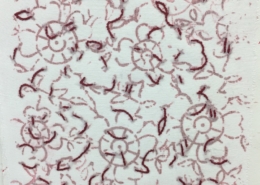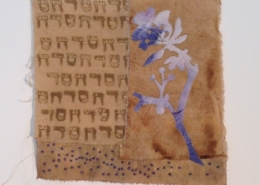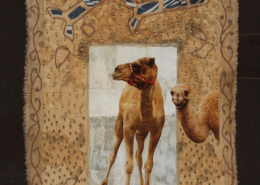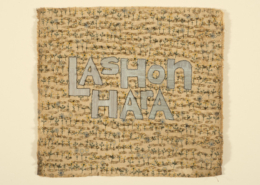The Ten Plagues
The Kabbalah teaches that every human soul is compromised of 10 points of energy, ten characteristics that make up our inner personality. These are known as the 10 sefirot (“lights”). In my interpretation of the Ten Plagues I use their opposing Kabbalistic attributes to tell the story of deliverance and redemption.
The Second Plague: The Plague of Frogs (Yesod /Intimacy – Cold Intimacy) Frogs, 2016 Mixed media on fabric, 10 ½” x 10 ½”
Frogs are cold-blooded creatures who deposit their eggs into cold moist holes. Their young receive no parental protection and reflect the emotional state of apathy, detachment and coldness — the inability to connect or experience genuine emotional intimacy.
The frogs in this piece were inspired from an ancient Mexican motif from the Museum of Anthropologie in Mexico, DF. The frogs arrive from the heavens as eggs pelting the ground at lightening speed; fully formed frogs bursting forth from their shells. The first two plagues were exacerbated by Pharaoah’s sorcerers who showed Moses and Aaron that they too could cast their “magical spells” conjuring up both blood and frogs; adding their own hand to the misery of the land.
The Fourth Plague: Wild Beasts/Flying Things (Netzach /Ambition – Wild Ambition)
Camels and Rockets, 2016 mixed media on fabric, 10 1/2 ” x 15″
Ambition is a character trait that can drive one to do great things; but, if ones character is not “refined” we can easily turn into “devouring beasts” that crush and destroy all that stand in our way.
There seems to be some disagreement among torah scholars whether or not this is the plague of wild beasts or flying things. In this piece, inspired by a photograph of the Israeli Army’s Iron Dome I created the idea of both. The “flying things” are represented by Israeli rockets shooting down missiles sent to maim and destroy our people. Pensive camels hear the noise — perhaps in ancient times they were the wild beasts; having been enslaved, beaten and abused by their masters, they too rose up en masse trampling and pillaging everything in site.
The Fifth Plague: Pestelence (Tif’eret/Compassion – Sly Compassion) Pestelence, 2016 mixed media on fabric, 29 ¼” x 10 ¼”
Compassion considers all the flaws of an individual and extends a helping heart — it’s the ability of one’s soul to experience the pain and needs of his fellow man. Egyptian compassion was sly, shrewd and deceitful. It exploited other’s weaknesses for selfish purposes and destructive goals. This type of compassion inflicts damage silently and deadly.
I likened Pestelence to a great plague — a rat born plague — rats having the sly, shrewd and deceitful characteristics of the Egyptians and also because they represent of Hashem’s lowliest creatures. In this piece I replicated sets of rat prints running hither and yon scurrying over the fabric, carrying with them filth and disease in their wake. The red thread symbolizes both the of the rings of a tree (the Jewish people) as well as Hashem’s timeless protection of them.
The Eighth Plague: Locusts (Binah/Intelligence – Perverted Intelligence) Locust (You Are What You Eat), 2016 mixed media collage on fabric, 8 ½” x 11″
The Plague of Locusts left nothing green in Egypt. It is the embodiment of the destructive consequences of a corrupt mind. The remaining barren soil reminds us that a corrupt mind like the Pharoah’s can uproot every moral structure and sacred foundation leaving its people with empty spiritual values and principles. It has been written that the tragedy of Egypt intellectualism was that “one became so open minded that his brains fell out.”
In this piece the locust is up close. We can see the beauty of Egypt once green and lush represented in his feathery coat. He is sizing up his next meal. The remnants of what is left of the vegitation is depicted as negative space a ghost like outline where abundance and beauty once flourished.
The Tenth Plague: Death of the First Born (Keter/Supra-conscious – Death of Identity)
Raish, 2016 mixed media monotype, 8 ½” X 11 ½”
The death of the first born reminded the Pharoah and his Egyptians that abuse of the soul affects it’s conscious and supra conscious forces. This was the final “bullet” that ended the vicious cycle of abuse of the Jewish people.
I used the letter raish because it reminded me of the marks left in blood on the lintels and door posts of every Jewish home as a means of signaling the Angel of Death to pass over. It’s message is triangular in nature and conveys the idea that all three parts of the triangle: thought, speech and action must be in take place in order to achieve success.






